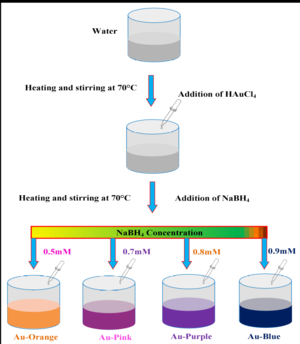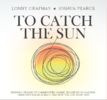
Gold nanoparticles (AuNPs) including Au-Pink, Au-Orange, Au-Purple, Au-Blue were synthesized using chemical reduction method, their optical and morphological properties were characterized and they were used in PV devices. The active layer of dye-sensitized solar cells having titanium dioxide (TiO2) solid microsphere (MS) made up of nanoparticles granules were coated with AuNPs. This Au-TiO2 MS hybrid DSSC boosted light harvesting, charge separation, and improved the charge transportresulting in an improvement of both short circuit current and open circuit voltage. The power conversion was boosted 16% compared to the control photoanode of TiO2 solid microsphere. Further enhancement in the short circuit current was observed during the incorporation of both Au and Ag, bi-metallic nanoparticles in the TiO2 matrix. An overall photo to electron conversion efficiency of 8.73% was obtained due to the plasmoniccooperation effect of TiO2-Ag-Au hybrid structures, which is 65% increase over pure TiO2 DSSCs. The local electrified intensity enhancement around the individual Ag, Au nanoparticles and plasmonic coupling of the Ag-Au combination have been used to explain these results with finite-difference time-domain simulation.
Source
- R. Selvapriya, J. Vinodhini, T. Abhijith, V. Sasirekha, V. Ragavendran, J.M. Pearce, J. Mayandi. Fabrication of Bimetallic Inlaid Working Electrode for Highly Efficient Dye Sensitized Solar Cells. Journal of Alloys and Compounds 939, 2023, 168634. https://doi.org/10.1016/j.jallcom.2022.168634.OA academia
DSSC; titanium dioxide; photovoltaic; Power conversion efficiency, dye sensitized solar cell, nanotechnology, nanoparticles, surface plasmon resonance
Highlights[edit | edit source]
- Plasmonic working electrode is prepared by drop casting multishaped Ag/Au NPs and immobilized by post TiCl4 treatment.
- Reduction in charge carrier recombination is evidenced.
- Bimetallic effect results in the overall photo to electron conversion efficiency of 8.73%.
- Plasmonic cooperation between bimetallic nanoparticles is confirmed via enhancement of local electric field simulated using FDTD.
See also[edit | edit source]
- Effect of microwave power irradiation on TiO2 nano-structures and binder free paste screen printed dye sensitized solar cells
- Peanut shaped ZnO microstructures: controlled synthesis and nucleation growth toward low-cost dye sensitized solar cells
- Dual morphology titanium dioxide for dye sensitized solar cells
- Reaction Induced Multifunctional TiO2 Rod/Spherical Nanostructured Materials for Screen Printed Dye Sensitized Solar Cells
- Microwave-Assisted Synthesized Gadolinium Doped Barium Strontium Titanate Nanostructures: Structural and Optical Properties for DSSC Applications
- Impact of Coupled Plasmonic Effect with Multishaped Silver Nanoparticles on Efficiency of Dye Sensitized Solar Cells
- Enhanced Dye-Sensitized Solar Cell Performance using Strontium Titanate Perovskite Integrated Photoanodes Modified with Plasmonic Silver Nanoparticles
- Visible light driven photocatalytic performance of 3D TiO2/g-C3N5 nanocomposites via Z-scheme charge transfer promotion for water purification
- The use of urea as an N-doping 3D hierarchical preserving agent for titanium dioxide nanostructures tailored for dye-sensitized solar cells




